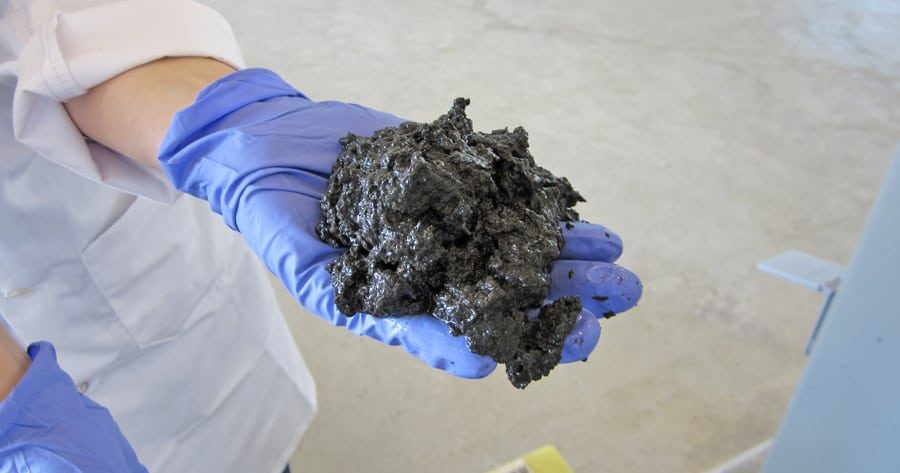
Home » Fuel from human waste, algae could be lucrative sources for biofuels
Fuel from human waste, algae could be lucrative sources for biofuels

April 13, 2017
Pacific Northwest National Laboratory in Richland is looking at a couple of potentially lucrative sources for biofuels.
Poop and algae.
The poop approach will be tested on a full scale soon in Vancouver, B.C. The algae approach is eventually headed for tests at an Arizona facility.
Biofuels refer to a wide range of fuels created by different processes for a wide variety of purposes. They are usually created with sugar, or with cover crops such as camelina, or with wood wastes such a leftover slash of downed trees, among other sources. A July 2016 U.S. Department of Energy report concluded that the nation has the partly-untapped potential to produce at least 1 billion tons of crops, biomass from forests and other waste materials capable of replacing 30 percent of the United States’ 2005 petroleum consumption.
Biofuels result in fewer carbon emissions than petroleum-based fuels.
PNNL is working on two additional unconventional sources for biofuels.
One source is sewage — with plenty of toilet paper, plus some grease, fats and oils mixed in.
PNNL believes that a single person can produce two to three gallons of biocrude oil annually just by doing what comes naturally and inevitably to each one of us.
PNNL has been tinkering on and off with biofuels since the 1970s. The lab’s scientists ended up focusing on the grease, fats and oils in sewage as a potential source of biocrude oil. The problem has always been that sewage sludge is too soggy to produce usable biocrude oil. And until recently, engineering issues have kept scientists from drying the sewage sludge into a biocrude oil-friendly substance.
Those engineering problems have been solved — at least in the laboratory.
The process is called hydrothermal liquidification. That means the sludge in a lab setting flows through a long, narrow tube — 1/3-inch to 1/2-inch in diameter — under a pressure of 3,000 pounds per square inch while being heated to 660 degrees Fahrenheit. The resulting biocrude can then be refined into usable biofuel, possibly for use in jet planes and other machinery.
Corinne Drennan, PNNL’s head of bioenergy technologies research, said 100 million gallons of sewage can produce 100 tons of dry biocrude sludge. The nation’s sewage plants treat roughly 34 billion gallons of sewage every day, which could translate to about 30 million 42-gallon barrels of oil a year, according to PNNL figures.
PNNL has licensed this technology to Utah-based Genifuel Corp., which is now working with Metro Vancouver.
Metro Vancouver has an $8 million to $9 million pilot project planned for its Annacis Island wastewater treatment plant, with construction expected to be complete by the end of 2018. The plant serves roughly 1 million people with 175 billion liters of wastewater going in each year, resulting in 16,000 metric tons of mixed sewage sludge being produced annually.
“Hydrothermal processing could be as dramatic as when the steam locomotive displaced the horse and carriage,” wrote Metro Vancouver spokeswoman Sarah Lusk in an email.
Drennan speculated that Metro Vancouver might send its biocrude to an existing Northwest refinery for the final processing. She acknowledged that the economics of sewage-based biofuel still need be studied and improved to make it financially feasible.
A second biofuel source being studied by PNNL is algae. Algae is a targeted source for creating biofuel to fight carbon pollution.
Algae’s big plus is that it grows much faster than other biofuel sources. Some algae can double in mass every two hours, and could theoretically be harvested daily. The U.S. Department of Energy estimates that to replace all the petroleum fuel in the country with home-grown algae fuel would require 15,000 square miles, which is less than one-seventh of the area devoted to growing corn in the United States. Also, using algae would not interfere with food production, which would be a factor in using sugar.
In a 2013 interview with Bloomberg.com, J. Craig Venter of Synthetic Genomics Inc. contended that algae can produce biofuels 10 times the amount of ethanol created by a similar acreage of corn.
But biofuel is significantly more expensive than oil. In 2010, algae-based biofuel was estimated to cost $140 to $900 a barrel. That same year, oil cost $71 a barrel. At least 100 fledgling businesses are looking at developing algae-based biofuel. In 2015, an Israeli firm called Univerve claimed to have technology capable of eventually producing algae-based biofuel at $50 a barrel, which was slightly greater than the price of oil in 2015.
“Algae biofuel is a promising clean energy technology, but the current production methods are costly and limit its use,” said the Richland project’s lead researcher Micheal Huesemann at PNNL. “The price of biofuel is largely tied to growth rates. Our method could help developers find the most productive algae strains more quickly and efficiently.”
In the 2013 Bloomberg story, Rex Tillerson, then CEO of Exxon Mobil Corp. and now U.S. Secretary of State, said the corporation has invested $600 million in creating biofuel from algae, but does not expect results for 25 years because the algae does not grow quickly enough to create enough raw material to supply a refinery.
“We’ve come to understand some limits of that technology, or limits as we understand it today, which doesn’t mean it’s limited forever,” Tillerson said in the Bloomberg story.
The federal effort led by PNNL is systematically trying to find the fastest growing algae. Also involved are the Los Alamos National Laboratory, the National Renewable Energy Laboratory and Sandia National Laboratories. DOE is providing $6 million for the project. Since biofuels are significantly more expensive than petroleum-based fuels, a speedy renewable cycle will help keep costs down, Huesemann said.
PNNL is looking at 30 strains of algae, and trying to find the best four for speedy growth. The most promising algae strains will then be studied for oil, protein and carbohydrate components, which address their abilities to produce biofuels. The most promising also will be studied to see if they can produce useful byproducts.
The other national laboratories will simultaneously analyze different algae at different stages of the experimental processes.
A basic stage in that overall project is each strain spending six months in a PNNL lab being subjected to a variety of shifting lighting conditions and temperatures in glass containers called photobioreactors.
“We can simulate any pond in any place in the United States on any day,” Huesemann said.
After the lab studies, the algae will be test-grown at Arizona State University’s Arizona Center for Algae Technology and Innovation for additional analysis.
“Even if it does well in the lab, we don’t know how well it will do in a pond,” Huesemann said.
The goal is to have at least four prime strains of algae identified three years from now. The lab tests have just begun.
The airline industry and the federal government are aiming to cut commercial aviation carbon emissions to 50 percent of 2012 levels by 2050. In the case of jet fuel, biofuels are blended with petroleum-based fuels to cut down carbon emissions.
ASTM International — a more-than-a-century-old organization that sets technical standards for numerous industries worldwide — tests the blended fuel to see if it meets its requirements for jet fuel. ASTM has certified five biofuels for jet fuel use since 2011.
A major hurdle in getting airlines to use biofuels is the cost difference between biofuels and petroleum-based fuels. Right now, petroleum-based jet fuels are cheaper. Biofuels do not totally replace petroleum-based fuels when used in jets. Instead, they are mixed with petroleum-based fuels to reduce carbon emissions.
Another problem is that the prices of biofuels and petroleum-based fuels are constantly fluctuating. Also there are several processes — with varying expenses — for creating biofuels. And there are several sources for raw materials for biofuels: sugars, corn, other crops and wood. These sources have their own constantly shifting economic pictures.
Late last year, the Port of Seattle, the sustainable jet fuel company SkyNRG and Sir Richard Branson’s nonprofit Carbon War Room announced they are partnering on a study to find out how to compensate airlines for the difference in fuel prices.
Their goal? To set up a way so all airlines at SeaTac International Airport can economically use biofuel for their passenger jets. They want SeaTac to become the first American airport to provide biofuel for all of its passenger planes. Worldwide, only the airport in Oslo, Norway, does that. In the United States, United Airlines uses biofuel in its airplanes leaving Los Angeles International Airport.
But another unknown is where the money will come from to compensate airlines for the greater cost of using biofuels. A central question is how the production of more biofuels can be spurred so it becomes more economical at larger volumes.
The nation uses roughly 23 billion gallons of aviation fuel a year, according to the Commercial Aviation Fuels Initiative, a national coalition of airlines, biofuel producers and government agencies. CAAFI has set a target of manufacturing 400 million gallons of biofuels a year by 2020.
Local News Environment
KEYWORDS april 2017





